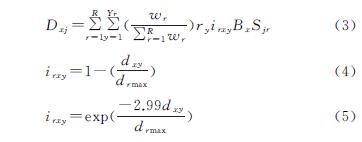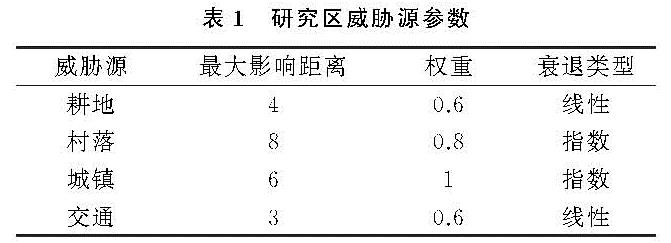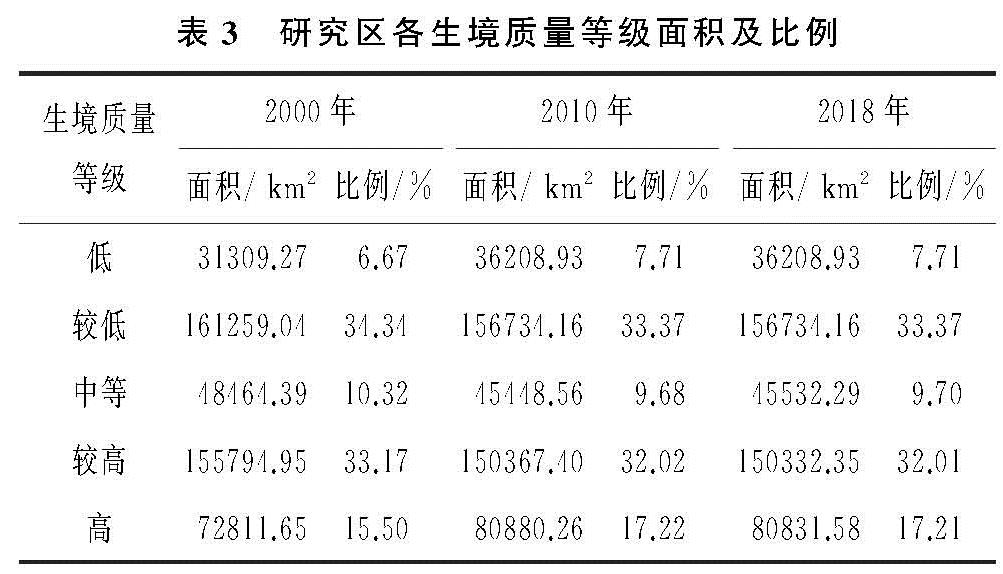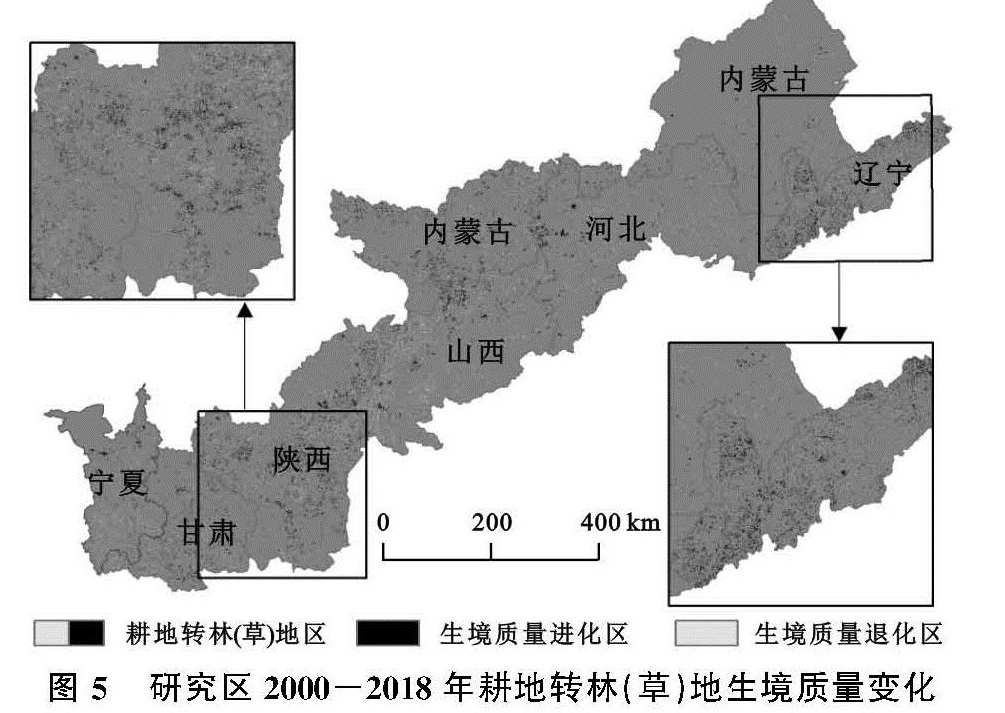2.1 土地利用变化分析
三期土地利用图经ArcMap软件统计所得结果见图1。可知,2000—2018年期间,北方农牧交错带土地利用类型以耕地,林地和草地为主,三者面积共计超过4.3×105 km2,近占比超过91.83%。面积最大的是草地,2000年时面积最大,超过研究区的40.00%; 面积最小的为水域,多年面积占比均在1.50%左右。从变化趋势来看,近20 a来北方农牧交错带土地利用类型处于减少趋势的为耕地、草地和未利用地,减少面积分别为5 852.58 km2,6 488.41 km2,557.59 km2; 林地、水域和建设用地则处于增加态势,增加面积分别为6 972.62 km2,173.45 km2,5 781.54 km2。
从变化速度来看,图2中建设用地无论是整个研究期还是分阶段来看,其相对变化程度都非常剧烈,动态度均高达0.02以上,其次是林地,在2000—2010年期间,动态度值为0.83×10-2,上升趋势较为急剧,但在2010—2018年期间则变化极为缓和。耕地和草地的变化趋势较为相似,两者动态度在各阶段均较为相近。总体来看,水域、建设用地和未利用地在前一时期变化程度均不如后一时期剧烈,尤其表现在耕地、林地、草地的变化显著发生于2000—2010年时期,三者作为研究区主要的土地利用类型,对该区的土地利用整体的变化特征的解释最具代表性。可以认为,自退耕还林(草)政策实施以来,北方农牧交错带地区取得了一定成效,最大成效期发生在2000—2010年,主要表现在“还林”部分,而“还草”的效果并未达到预期。经分析,北方农牧交错带区域多年来因气候条件恶劣及人为因素干扰,该区草地退化严重并被建设用地大面积占用,导致草地多年来萎缩明显,“还草”起到的更多是对草地减少的抑制效果。
2.2 生境质量变化分析
经InVEST模型运行所得2000—2018年北方农牧交错带生境质量指数HQI(Habitat Quality Index)见图3,相应的面积统计见表3。在ArcMap软件中根据平均间隔进行分区,得到生境质量低级区(0≤HQI<0.2),较低级区(0.2≤HQI<0.4),中级区(0.4≤HQI<0.6),较高级区(0.6≤HQI<0.8),高级区(0.8≤HQI<1.0)。
由表3可知,2000—2018年北方农牧交错带地区生境质量水平以较低等级和较高等级生境质量为主,总面积超过307 066.51 km2,多年来占比均在32%~35%,呈现两级分化状态。生境质量较低及以下等级区域占比超过40%,生境质量较高及以下等级区域占据研究区近一半,超过48%。中等级质量区域最高为48 464.39 km2,最低时占比为9.68%。研究区低等级生境质量区域面积最少,生境质量数值区间主要集中在0.2~1.0。从整个研究区变化情况来看,2000—2010年生境质量变化最为显著,主要变现为低等级、高等级生境质量区的扩张,相应面积分别为4 899.66 km2,8 068.61 km2; 同时较低、中等、较高等级生境质量区不同程度下降,分别减少了0.97,0.64,1.15个百分点。
研究区在2010—2018年生境质量变化不够明显,生境质量较低以下等级区域基本没有发生变化,中等及以上等级区变化程度非常微小。该现象经分析,原因有二,其一为基于土地利用视角的生境质量变化中,当土地利用变化不明显时,生境质量变化亦然; 其二乃生境质量等级的分区区间偏大造成未分区前生境质量具体数值的变化值也集中在生境质量等级未发生变化的区间中。由图3可知,研究期间生境质量较高区域主要在陕西南部、山西南部、河北东南部及辽宁西南部地区,较低区主要在陕西北部、内蒙古中部及河北西北部。整体来看,2000—2018年北方农牧交错带整体生境质量处于“南高北低”的分布状态,
2.3 生境质量数量转移分析
通过ENVI软件对北方农牧交错带2000年和2018年生境质量图谱进行变化检测后所得统计数据见表4。可知,2000—2018年期间,研究区生境质量区域变化较大的主要发生在较低级到较高级、高级到较高级、较高级到较低级生境质量区域的转移,转入面积均在6 800~7 200 km2。其次为高级和低级到较低等级的土地转入,相应面积均接近4 000~4 800 km2。较高层级到较低层级生境质量的土地互相转入的程度大抵相等,约在6 900 km2左右; 研究区转入较低等级生境质量的土地面积最大,总额近14 000 km2,而转入高等级质量生境的面积也高达13 000 km2,两者比较下,生境的退化影响略高于进化。
研究期间,中等级别生境质量区域退化程度大于进化程度,其向低级及较低等级转入面积共计3 376 km2,而转入较高及以上区域面积仅为1 723 km2,差值约为1 652 km2。较低及以下等级生境质量区域转为较高及以上等级区域为11 219.90 km2,略微低于对应的逆向转化的总面积12 931.44 km2,尽管生境质量进化区域低于退化区域1 171.54 km2,但结合表4中较高及高等级生境质量区域退化成较低及低等级生境的面积来看,其远低于较低及以下层级向较高以上层级生境区域的转化,退化程度低于进化程度。可以认为,北方农牧交错带区域在2000—2018年期间生境质量在整体上趋于更优。
表4 研究区2000-2018年不同生境质量等级区土地转移矩阵km2
2.4 生境质量空间转移分析
通过栅格计算器对2018年和2000年生境质量图栅格图进行相减得到图4。可以发现北方农牧交错带2000—2018年生境质量显著变化区域主要在陕西、辽宁两省全境,其中陕西省是最早实施退耕还林政策的试点区之一,上述区能较明显分辨出生境质量进化区域多于退化区,两区整体生境呈现更优趋势。同时可知,土地利用变化的程度一定程度上决定了生境质量变化的水平,山西、辽宁两省在研究期间土地更迭程度较显著,辽宁省土地利用变化最剧烈。从局部来看,在河北中西部及东北部、陕西北部、内蒙古西部及东部部分区域生境质量也发生了较为显著的变化。其中内蒙古东、西部生境退化程度尤为明显,山西及河北涉及地区生境质量变化区域趋于两极化。甘肃、宁夏地区生境质量变化不够明显,除宁夏东北部有一定程度变化,两省其余区域均“偏灰”。可以发现,生境质量变化区域集中在北方农牧交错带中心核心地带,即B,C,D,E样区,所涉地区处于耕地与林草地交错的典型地段,且城镇化水平相比其余区域明显较高,该区局部生境质量变化与城镇化水平、农区牧区交错程度密不可分。同时从整体上看,近20 a来研究区生境质量变化趋向“偏白”,生境向更优态势转变。
2.5 退耕还林还草对生境质量的影响
通过提取了北方农牧交错带2000—2018年土地转移图中耕地转为林、草地的图层,设置该图层耕地转林、草区域的栅格值为1,其余部分全为0,得到了研究区退耕还林还草二值图。通过栅格计算器,将该二值图单元栅格值与2000—2018年研究区生境变化图单元栅格值进行相乘处理,得到结果为研究区退耕还林区域生境质量的变化情况,具体见图5。整体上看,可明显分辨研究区整体“偏黑”,退耕还林还草下生境质量变好的栅格数明显高于变差的栅格数,经生境指数栅格数统计,2000—2018年退耕还林还草区域生境质量进化区域面积7 279.37 km2,占比86%; 退耕还林还草区域退化区域达到1 181.60 km2,占比14%。研究区耕地转林(草)区域生境质量显著地提高。同时对比图5可知,内蒙古东北部、河北东部耕地转林草地的迹象不够明显,而辽宁、陕西、河北中东部、山西北部、内蒙古西南部退耕还林还草效果较为显著,与图4中生境质量变化区域基本吻合,说明该区内退耕还林还草政策已经取得了一定成效,生境质量有所提升。结合以上分析可以认为,退耕还林还草政策是驱动北方农牧交错带生境质量变化主要原因之一,同时可以认定,在土地利用变化中,耕地转林、草地在一定程度上会提高该变化区域的生境质量水平。
图5 研究区2000-2018年耕地转林(草)地生境质量变化













